System Analysis and Design: Case for Waterfall Life Cycle Methodology
VerifiedAdded on 2020/04/15
|12
|2862
|215
Report
AI Summary
This report provides a comprehensive analysis of the Waterfall life cycle methodology within the context of system analysis and design. It begins with an introduction to the Waterfall model, describing it as a sequential and linear approach to project management, particularly suitable for small to medium-sized projects with clearly defined phases. The report then delves into the core concepts of the Waterfall life cycle, outlining its various stages, including requirement analysis, system design, implementation, testing, system deployment, and maintenance. The importance of the Waterfall methodology, highlighting its simplicity, ease of use, and clear project scope, is discussed. Furthermore, the report evaluates the model's role in modern system development, acknowledging the rise of agile and iterative methods while recognizing the continued relevance of Waterfall, especially for projects with budget constraints or well-documented requirements. The advantages and disadvantages of using the Waterfall model are elaborated, including its structured approach and clear documentation, alongside its inflexibility and unsuitability for complex projects. The report concludes by summarizing the model's strengths and weaknesses and its suitability for specific project types, including a discussion on the iterative and spiral models that are advanced forms of the traditional waterfall methodology.

Running head: SYSTEM ANALYSIS AND DESIGN
System Analysis and Design: Examining the Case for the Waterfall Life Cycle
Name of the Student
Name of the University
Author Note
System Analysis and Design: Examining the Case for the Waterfall Life Cycle
Name of the Student
Name of the University
Author Note
Paraphrase This Document
Need a fresh take? Get an instant paraphrase of this document with our AI Paraphraser
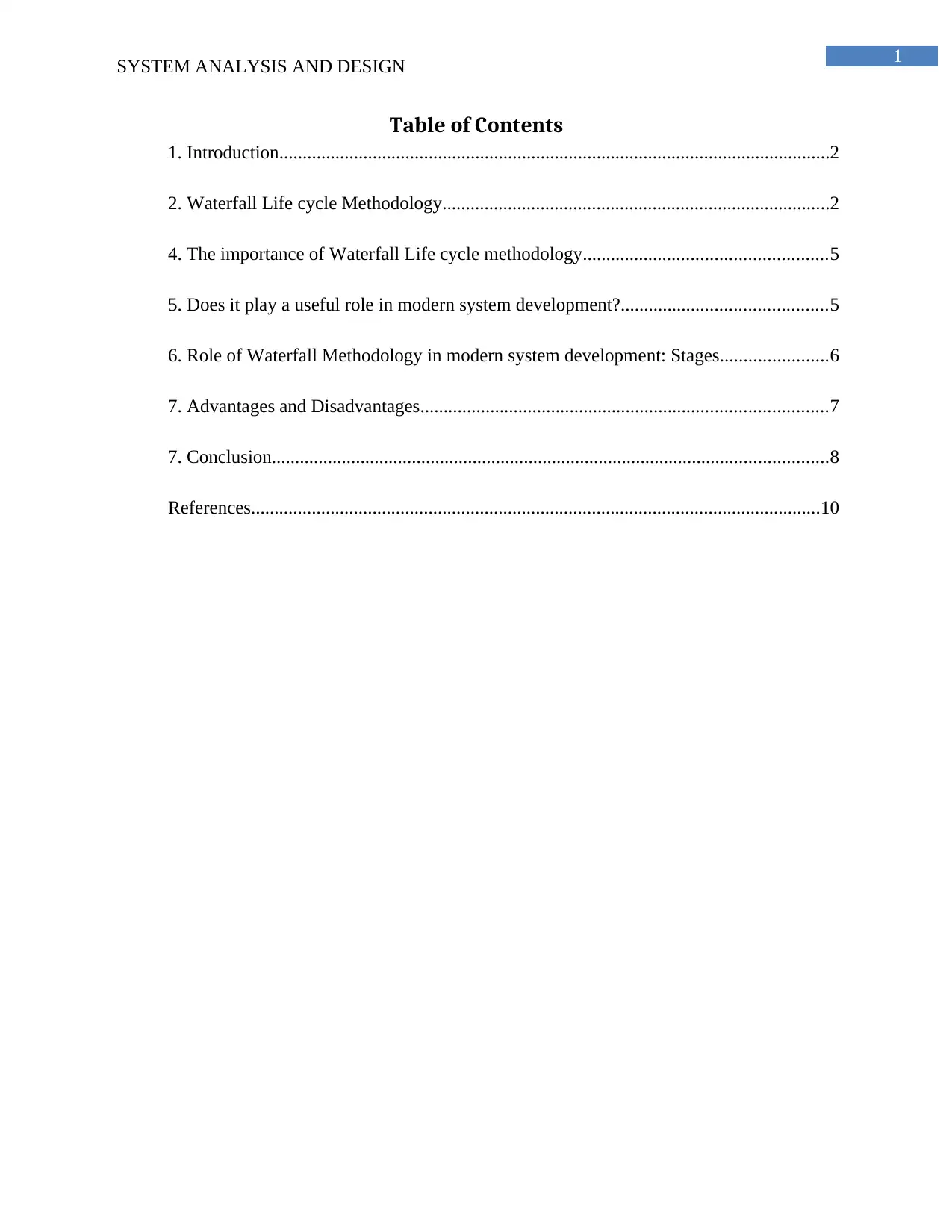
1
SYSTEM ANALYSIS AND DESIGN
Table of Contents
1. Introduction......................................................................................................................2
2. Waterfall Life cycle Methodology...................................................................................2
4. The importance of Waterfall Life cycle methodology....................................................5
5. Does it play a useful role in modern system development?............................................5
6. Role of Waterfall Methodology in modern system development: Stages.......................6
7. Advantages and Disadvantages.......................................................................................7
7. Conclusion.......................................................................................................................8
References..........................................................................................................................10
SYSTEM ANALYSIS AND DESIGN
Table of Contents
1. Introduction......................................................................................................................2
2. Waterfall Life cycle Methodology...................................................................................2
4. The importance of Waterfall Life cycle methodology....................................................5
5. Does it play a useful role in modern system development?............................................5
6. Role of Waterfall Methodology in modern system development: Stages.......................6
7. Advantages and Disadvantages.......................................................................................7
7. Conclusion.......................................................................................................................8
References..........................................................................................................................10
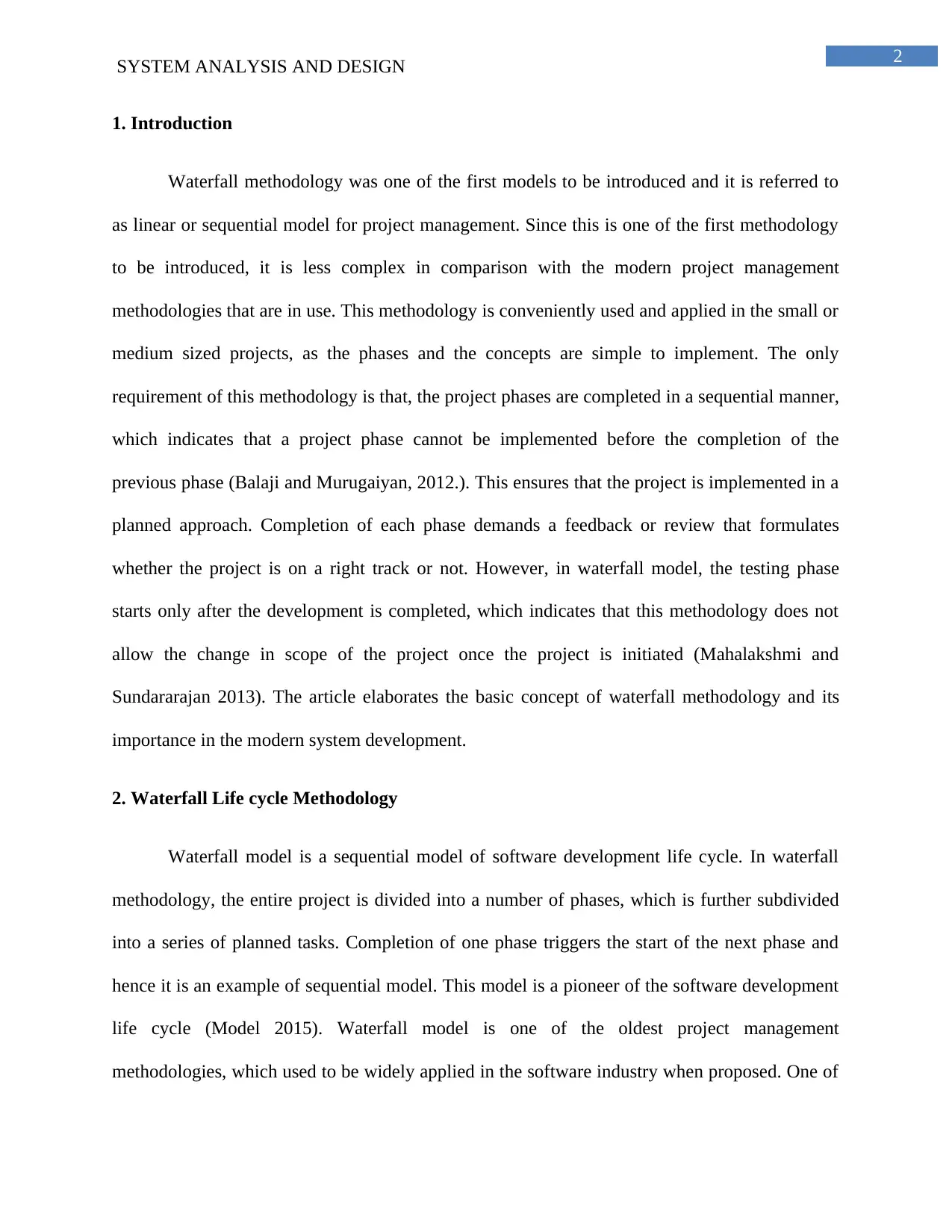
2
SYSTEM ANALYSIS AND DESIGN
1. Introduction
Waterfall methodology was one of the first models to be introduced and it is referred to
as linear or sequential model for project management. Since this is one of the first methodology
to be introduced, it is less complex in comparison with the modern project management
methodologies that are in use. This methodology is conveniently used and applied in the small or
medium sized projects, as the phases and the concepts are simple to implement. The only
requirement of this methodology is that, the project phases are completed in a sequential manner,
which indicates that a project phase cannot be implemented before the completion of the
previous phase (Balaji and Murugaiyan, 2012.). This ensures that the project is implemented in a
planned approach. Completion of each phase demands a feedback or review that formulates
whether the project is on a right track or not. However, in waterfall model, the testing phase
starts only after the development is completed, which indicates that this methodology does not
allow the change in scope of the project once the project is initiated (Mahalakshmi and
Sundararajan 2013). The article elaborates the basic concept of waterfall methodology and its
importance in the modern system development.
2. Waterfall Life cycle Methodology
Waterfall model is a sequential model of software development life cycle. In waterfall
methodology, the entire project is divided into a number of phases, which is further subdivided
into a series of planned tasks. Completion of one phase triggers the start of the next phase and
hence it is an example of sequential model. This model is a pioneer of the software development
life cycle (Model 2015). Waterfall model is one of the oldest project management
methodologies, which used to be widely applied in the software industry when proposed. One of
SYSTEM ANALYSIS AND DESIGN
1. Introduction
Waterfall methodology was one of the first models to be introduced and it is referred to
as linear or sequential model for project management. Since this is one of the first methodology
to be introduced, it is less complex in comparison with the modern project management
methodologies that are in use. This methodology is conveniently used and applied in the small or
medium sized projects, as the phases and the concepts are simple to implement. The only
requirement of this methodology is that, the project phases are completed in a sequential manner,
which indicates that a project phase cannot be implemented before the completion of the
previous phase (Balaji and Murugaiyan, 2012.). This ensures that the project is implemented in a
planned approach. Completion of each phase demands a feedback or review that formulates
whether the project is on a right track or not. However, in waterfall model, the testing phase
starts only after the development is completed, which indicates that this methodology does not
allow the change in scope of the project once the project is initiated (Mahalakshmi and
Sundararajan 2013). The article elaborates the basic concept of waterfall methodology and its
importance in the modern system development.
2. Waterfall Life cycle Methodology
Waterfall model is a sequential model of software development life cycle. In waterfall
methodology, the entire project is divided into a number of phases, which is further subdivided
into a series of planned tasks. Completion of one phase triggers the start of the next phase and
hence it is an example of sequential model. This model is a pioneer of the software development
life cycle (Model 2015). Waterfall model is one of the oldest project management
methodologies, which used to be widely applied in the software industry when proposed. One of
⊘ This is a preview!⊘
Do you want full access?
Subscribe today to unlock all pages.

Trusted by 1+ million students worldwide
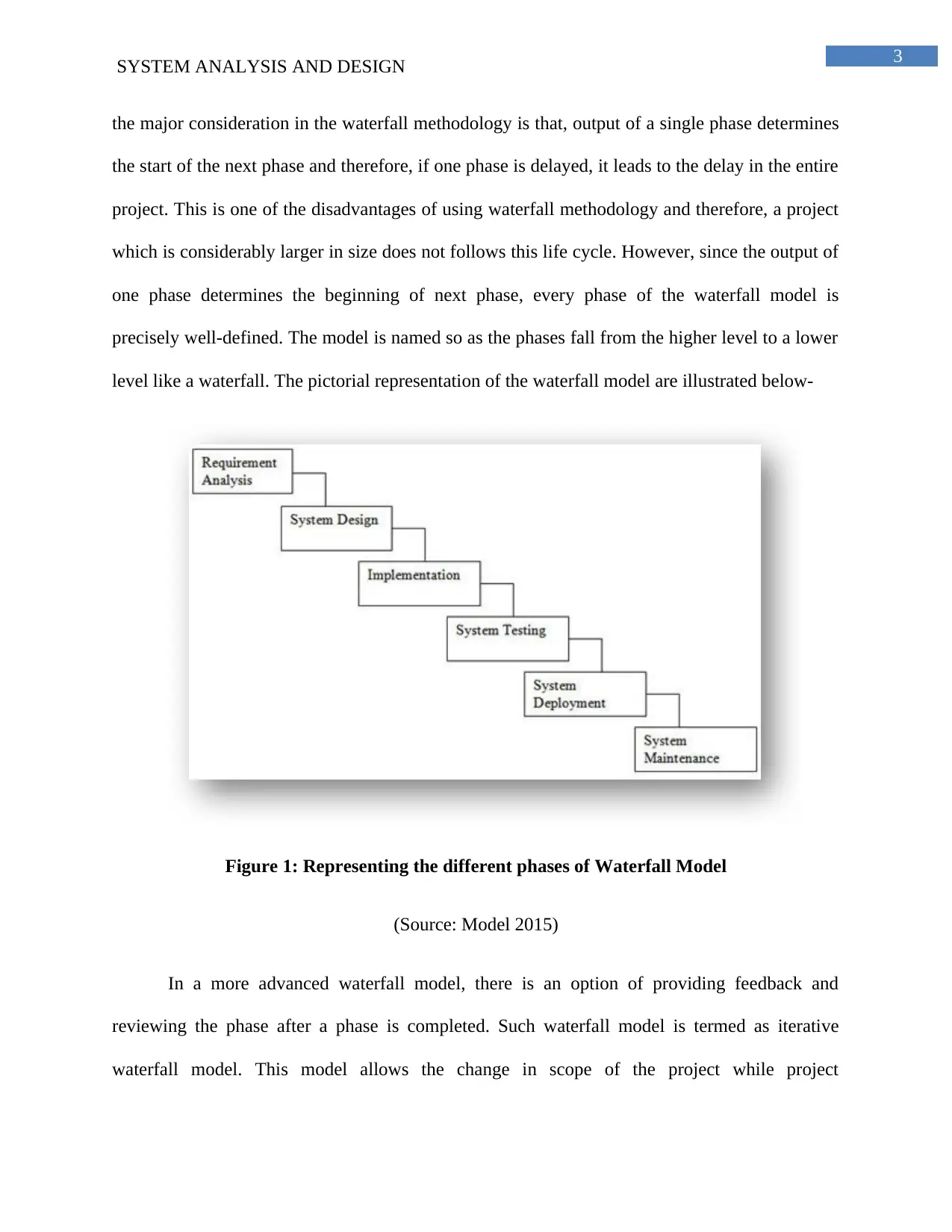
3
SYSTEM ANALYSIS AND DESIGN
the major consideration in the waterfall methodology is that, output of a single phase determines
the start of the next phase and therefore, if one phase is delayed, it leads to the delay in the entire
project. This is one of the disadvantages of using waterfall methodology and therefore, a project
which is considerably larger in size does not follows this life cycle. However, since the output of
one phase determines the beginning of next phase, every phase of the waterfall model is
precisely well-defined. The model is named so as the phases fall from the higher level to a lower
level like a waterfall. The pictorial representation of the waterfall model are illustrated below-
Figure 1: Representing the different phases of Waterfall Model
(Source: Model 2015)
In a more advanced waterfall model, there is an option of providing feedback and
reviewing the phase after a phase is completed. Such waterfall model is termed as iterative
waterfall model. This model allows the change in scope of the project while project
SYSTEM ANALYSIS AND DESIGN
the major consideration in the waterfall methodology is that, output of a single phase determines
the start of the next phase and therefore, if one phase is delayed, it leads to the delay in the entire
project. This is one of the disadvantages of using waterfall methodology and therefore, a project
which is considerably larger in size does not follows this life cycle. However, since the output of
one phase determines the beginning of next phase, every phase of the waterfall model is
precisely well-defined. The model is named so as the phases fall from the higher level to a lower
level like a waterfall. The pictorial representation of the waterfall model are illustrated below-
Figure 1: Representing the different phases of Waterfall Model
(Source: Model 2015)
In a more advanced waterfall model, there is an option of providing feedback and
reviewing the phase after a phase is completed. Such waterfall model is termed as iterative
waterfall model. This model allows the change in scope of the project while project
Paraphrase This Document
Need a fresh take? Get an instant paraphrase of this document with our AI Paraphraser
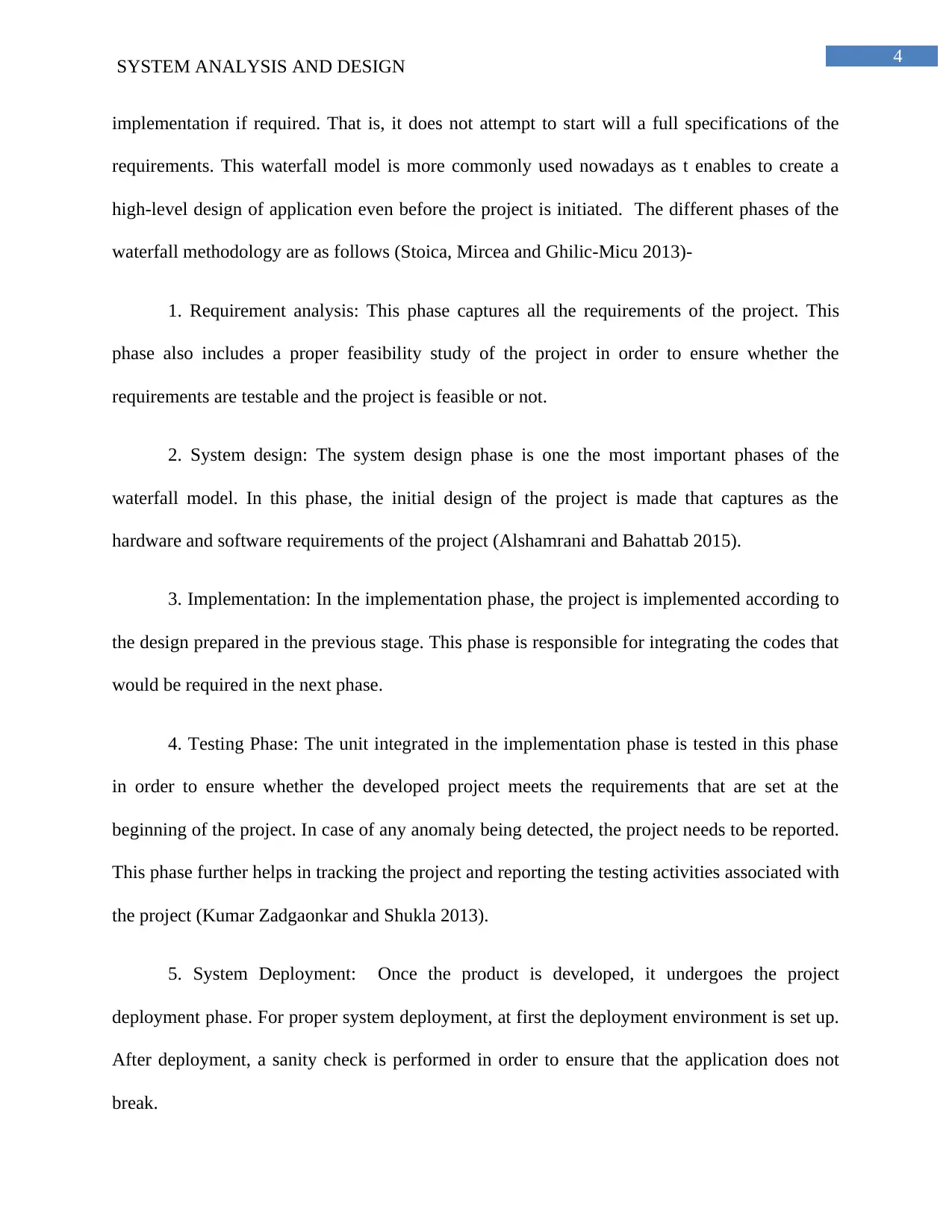
4
SYSTEM ANALYSIS AND DESIGN
implementation if required. That is, it does not attempt to start will a full specifications of the
requirements. This waterfall model is more commonly used nowadays as t enables to create a
high-level design of application even before the project is initiated. The different phases of the
waterfall methodology are as follows (Stoica, Mircea and Ghilic-Micu 2013)-
1. Requirement analysis: This phase captures all the requirements of the project. This
phase also includes a proper feasibility study of the project in order to ensure whether the
requirements are testable and the project is feasible or not.
2. System design: The system design phase is one the most important phases of the
waterfall model. In this phase, the initial design of the project is made that captures as the
hardware and software requirements of the project (Alshamrani and Bahattab 2015).
3. Implementation: In the implementation phase, the project is implemented according to
the design prepared in the previous stage. This phase is responsible for integrating the codes that
would be required in the next phase.
4. Testing Phase: The unit integrated in the implementation phase is tested in this phase
in order to ensure whether the developed project meets the requirements that are set at the
beginning of the project. In case of any anomaly being detected, the project needs to be reported.
This phase further helps in tracking the project and reporting the testing activities associated with
the project (Kumar Zadgaonkar and Shukla 2013).
5. System Deployment: Once the product is developed, it undergoes the project
deployment phase. For proper system deployment, at first the deployment environment is set up.
After deployment, a sanity check is performed in order to ensure that the application does not
break.
SYSTEM ANALYSIS AND DESIGN
implementation if required. That is, it does not attempt to start will a full specifications of the
requirements. This waterfall model is more commonly used nowadays as t enables to create a
high-level design of application even before the project is initiated. The different phases of the
waterfall methodology are as follows (Stoica, Mircea and Ghilic-Micu 2013)-
1. Requirement analysis: This phase captures all the requirements of the project. This
phase also includes a proper feasibility study of the project in order to ensure whether the
requirements are testable and the project is feasible or not.
2. System design: The system design phase is one the most important phases of the
waterfall model. In this phase, the initial design of the project is made that captures as the
hardware and software requirements of the project (Alshamrani and Bahattab 2015).
3. Implementation: In the implementation phase, the project is implemented according to
the design prepared in the previous stage. This phase is responsible for integrating the codes that
would be required in the next phase.
4. Testing Phase: The unit integrated in the implementation phase is tested in this phase
in order to ensure whether the developed project meets the requirements that are set at the
beginning of the project. In case of any anomaly being detected, the project needs to be reported.
This phase further helps in tracking the project and reporting the testing activities associated with
the project (Kumar Zadgaonkar and Shukla 2013).
5. System Deployment: Once the product is developed, it undergoes the project
deployment phase. For proper system deployment, at first the deployment environment is set up.
After deployment, a sanity check is performed in order to ensure that the application does not
break.
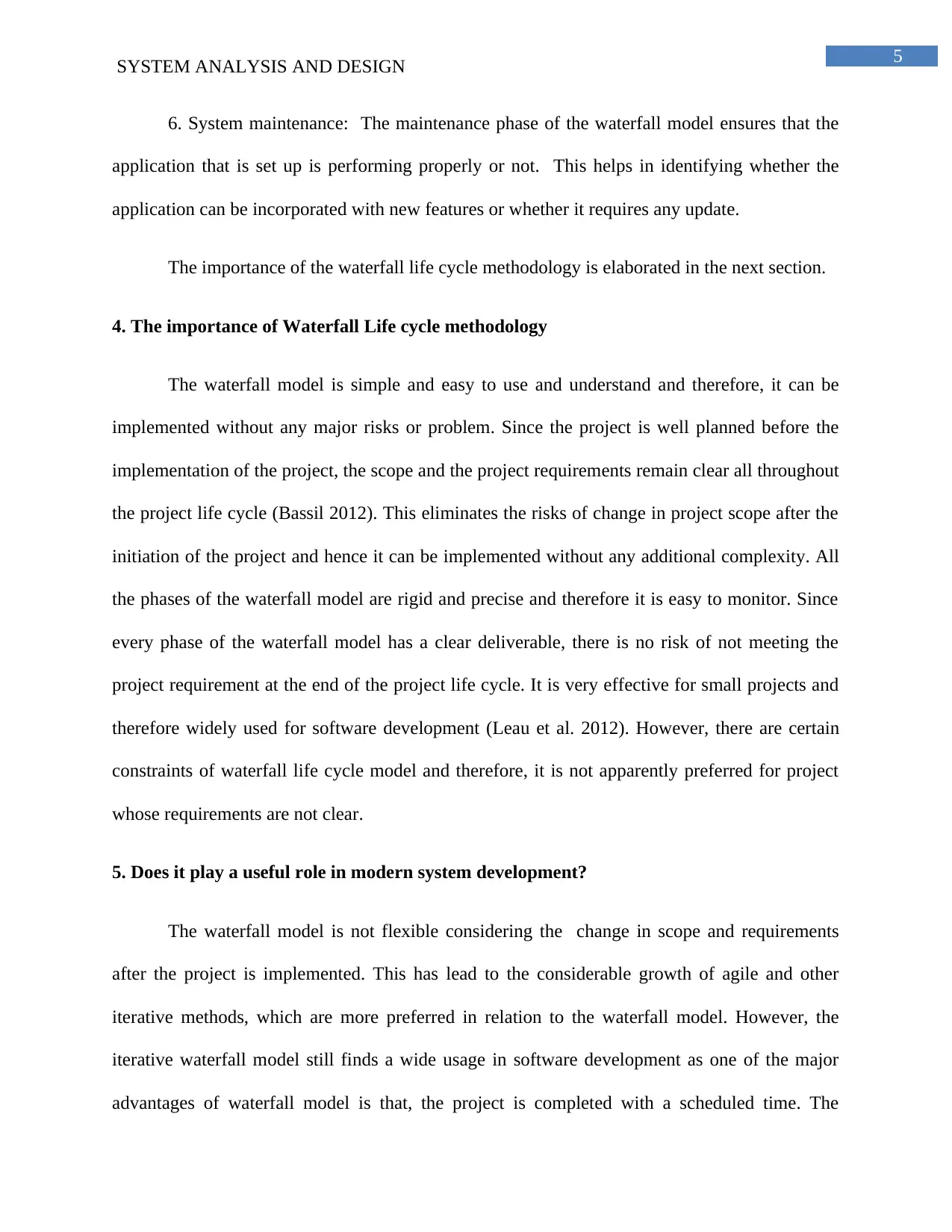
5
SYSTEM ANALYSIS AND DESIGN
6. System maintenance: The maintenance phase of the waterfall model ensures that the
application that is set up is performing properly or not. This helps in identifying whether the
application can be incorporated with new features or whether it requires any update.
The importance of the waterfall life cycle methodology is elaborated in the next section.
4. The importance of Waterfall Life cycle methodology
The waterfall model is simple and easy to use and understand and therefore, it can be
implemented without any major risks or problem. Since the project is well planned before the
implementation of the project, the scope and the project requirements remain clear all throughout
the project life cycle (Bassil 2012). This eliminates the risks of change in project scope after the
initiation of the project and hence it can be implemented without any additional complexity. All
the phases of the waterfall model are rigid and precise and therefore it is easy to monitor. Since
every phase of the waterfall model has a clear deliverable, there is no risk of not meeting the
project requirement at the end of the project life cycle. It is very effective for small projects and
therefore widely used for software development (Leau et al. 2012). However, there are certain
constraints of waterfall life cycle model and therefore, it is not apparently preferred for project
whose requirements are not clear.
5. Does it play a useful role in modern system development?
The waterfall model is not flexible considering the change in scope and requirements
after the project is implemented. This has lead to the considerable growth of agile and other
iterative methods, which are more preferred in relation to the waterfall model. However, the
iterative waterfall model still finds a wide usage in software development as one of the major
advantages of waterfall model is that, the project is completed with a scheduled time. The
SYSTEM ANALYSIS AND DESIGN
6. System maintenance: The maintenance phase of the waterfall model ensures that the
application that is set up is performing properly or not. This helps in identifying whether the
application can be incorporated with new features or whether it requires any update.
The importance of the waterfall life cycle methodology is elaborated in the next section.
4. The importance of Waterfall Life cycle methodology
The waterfall model is simple and easy to use and understand and therefore, it can be
implemented without any major risks or problem. Since the project is well planned before the
implementation of the project, the scope and the project requirements remain clear all throughout
the project life cycle (Bassil 2012). This eliminates the risks of change in project scope after the
initiation of the project and hence it can be implemented without any additional complexity. All
the phases of the waterfall model are rigid and precise and therefore it is easy to monitor. Since
every phase of the waterfall model has a clear deliverable, there is no risk of not meeting the
project requirement at the end of the project life cycle. It is very effective for small projects and
therefore widely used for software development (Leau et al. 2012). However, there are certain
constraints of waterfall life cycle model and therefore, it is not apparently preferred for project
whose requirements are not clear.
5. Does it play a useful role in modern system development?
The waterfall model is not flexible considering the change in scope and requirements
after the project is implemented. This has lead to the considerable growth of agile and other
iterative methods, which are more preferred in relation to the waterfall model. However, the
iterative waterfall model still finds a wide usage in software development as one of the major
advantages of waterfall model is that, the project is completed with a scheduled time. The
⊘ This is a preview!⊘
Do you want full access?
Subscribe today to unlock all pages.

Trusted by 1+ million students worldwide
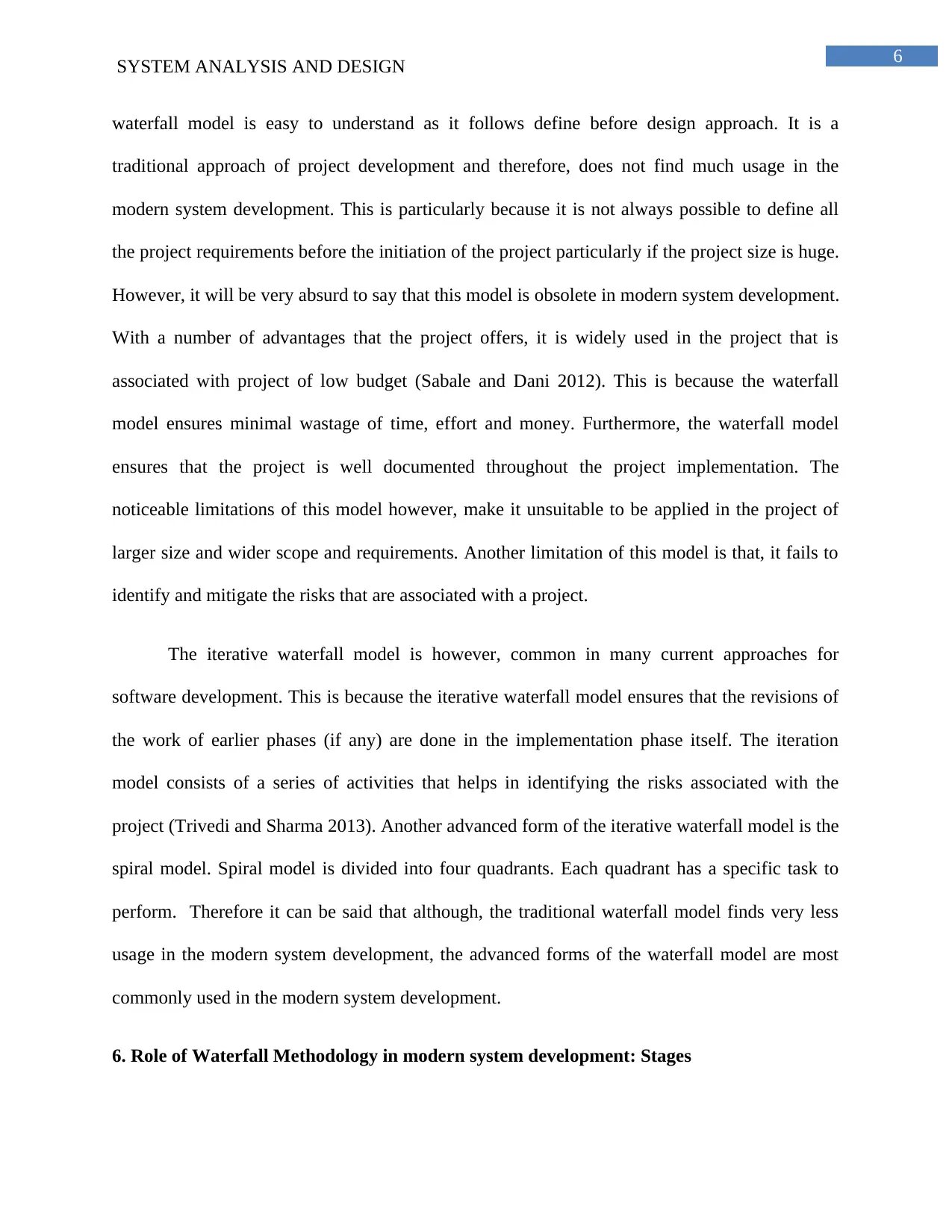
6
SYSTEM ANALYSIS AND DESIGN
waterfall model is easy to understand as it follows define before design approach. It is a
traditional approach of project development and therefore, does not find much usage in the
modern system development. This is particularly because it is not always possible to define all
the project requirements before the initiation of the project particularly if the project size is huge.
However, it will be very absurd to say that this model is obsolete in modern system development.
With a number of advantages that the project offers, it is widely used in the project that is
associated with project of low budget (Sabale and Dani 2012). This is because the waterfall
model ensures minimal wastage of time, effort and money. Furthermore, the waterfall model
ensures that the project is well documented throughout the project implementation. The
noticeable limitations of this model however, make it unsuitable to be applied in the project of
larger size and wider scope and requirements. Another limitation of this model is that, it fails to
identify and mitigate the risks that are associated with a project.
The iterative waterfall model is however, common in many current approaches for
software development. This is because the iterative waterfall model ensures that the revisions of
the work of earlier phases (if any) are done in the implementation phase itself. The iteration
model consists of a series of activities that helps in identifying the risks associated with the
project (Trivedi and Sharma 2013). Another advanced form of the iterative waterfall model is the
spiral model. Spiral model is divided into four quadrants. Each quadrant has a specific task to
perform. Therefore it can be said that although, the traditional waterfall model finds very less
usage in the modern system development, the advanced forms of the waterfall model are most
commonly used in the modern system development.
6. Role of Waterfall Methodology in modern system development: Stages
SYSTEM ANALYSIS AND DESIGN
waterfall model is easy to understand as it follows define before design approach. It is a
traditional approach of project development and therefore, does not find much usage in the
modern system development. This is particularly because it is not always possible to define all
the project requirements before the initiation of the project particularly if the project size is huge.
However, it will be very absurd to say that this model is obsolete in modern system development.
With a number of advantages that the project offers, it is widely used in the project that is
associated with project of low budget (Sabale and Dani 2012). This is because the waterfall
model ensures minimal wastage of time, effort and money. Furthermore, the waterfall model
ensures that the project is well documented throughout the project implementation. The
noticeable limitations of this model however, make it unsuitable to be applied in the project of
larger size and wider scope and requirements. Another limitation of this model is that, it fails to
identify and mitigate the risks that are associated with a project.
The iterative waterfall model is however, common in many current approaches for
software development. This is because the iterative waterfall model ensures that the revisions of
the work of earlier phases (if any) are done in the implementation phase itself. The iteration
model consists of a series of activities that helps in identifying the risks associated with the
project (Trivedi and Sharma 2013). Another advanced form of the iterative waterfall model is the
spiral model. Spiral model is divided into four quadrants. Each quadrant has a specific task to
perform. Therefore it can be said that although, the traditional waterfall model finds very less
usage in the modern system development, the advanced forms of the waterfall model are most
commonly used in the modern system development.
6. Role of Waterfall Methodology in modern system development: Stages
Paraphrase This Document
Need a fresh take? Get an instant paraphrase of this document with our AI Paraphraser
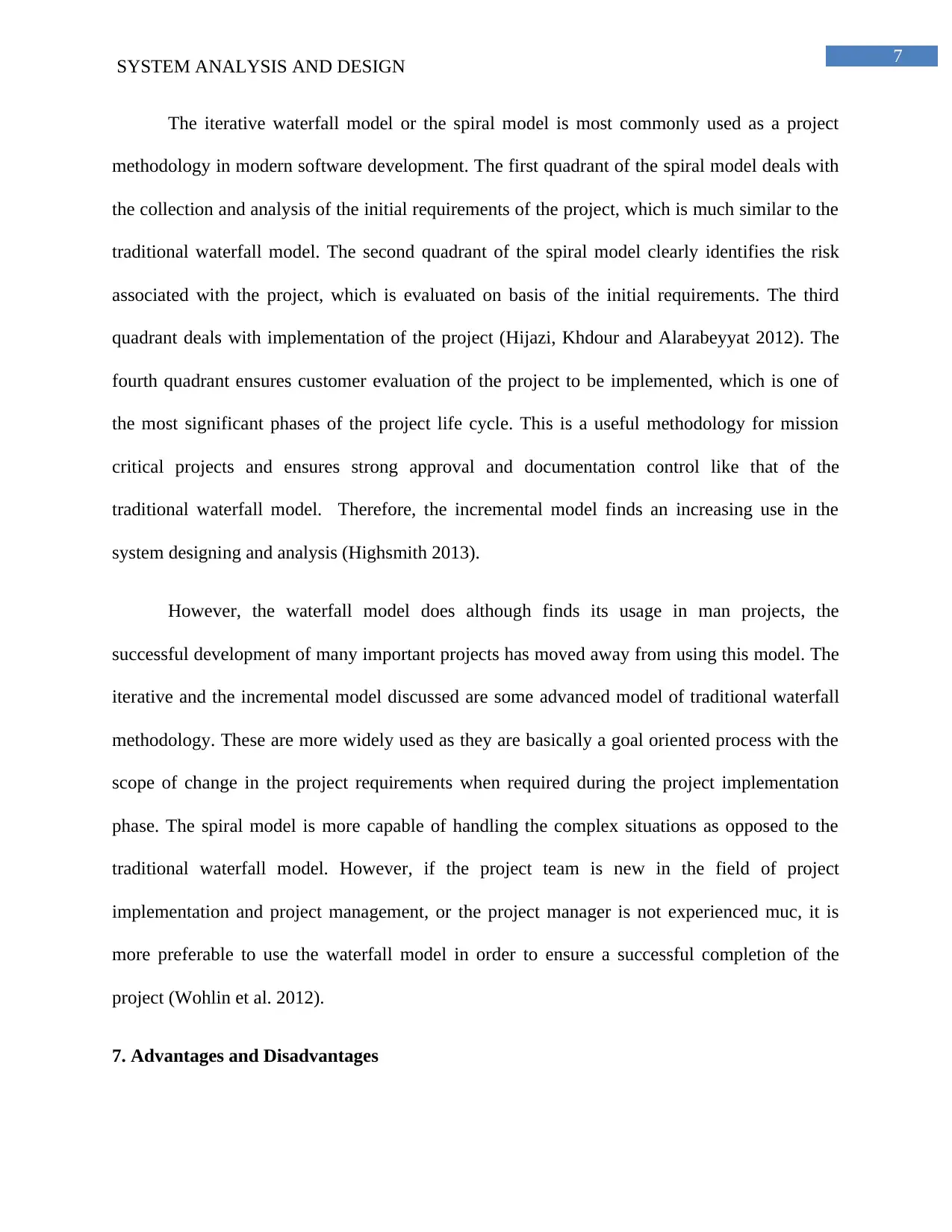
7
SYSTEM ANALYSIS AND DESIGN
The iterative waterfall model or the spiral model is most commonly used as a project
methodology in modern software development. The first quadrant of the spiral model deals with
the collection and analysis of the initial requirements of the project, which is much similar to the
traditional waterfall model. The second quadrant of the spiral model clearly identifies the risk
associated with the project, which is evaluated on basis of the initial requirements. The third
quadrant deals with implementation of the project (Hijazi, Khdour and Alarabeyyat 2012). The
fourth quadrant ensures customer evaluation of the project to be implemented, which is one of
the most significant phases of the project life cycle. This is a useful methodology for mission
critical projects and ensures strong approval and documentation control like that of the
traditional waterfall model. Therefore, the incremental model finds an increasing use in the
system designing and analysis (Highsmith 2013).
However, the waterfall model does although finds its usage in man projects, the
successful development of many important projects has moved away from using this model. The
iterative and the incremental model discussed are some advanced model of traditional waterfall
methodology. These are more widely used as they are basically a goal oriented process with the
scope of change in the project requirements when required during the project implementation
phase. The spiral model is more capable of handling the complex situations as opposed to the
traditional waterfall model. However, if the project team is new in the field of project
implementation and project management, or the project manager is not experienced muc, it is
more preferable to use the waterfall model in order to ensure a successful completion of the
project (Wohlin et al. 2012).
7. Advantages and Disadvantages
SYSTEM ANALYSIS AND DESIGN
The iterative waterfall model or the spiral model is most commonly used as a project
methodology in modern software development. The first quadrant of the spiral model deals with
the collection and analysis of the initial requirements of the project, which is much similar to the
traditional waterfall model. The second quadrant of the spiral model clearly identifies the risk
associated with the project, which is evaluated on basis of the initial requirements. The third
quadrant deals with implementation of the project (Hijazi, Khdour and Alarabeyyat 2012). The
fourth quadrant ensures customer evaluation of the project to be implemented, which is one of
the most significant phases of the project life cycle. This is a useful methodology for mission
critical projects and ensures strong approval and documentation control like that of the
traditional waterfall model. Therefore, the incremental model finds an increasing use in the
system designing and analysis (Highsmith 2013).
However, the waterfall model does although finds its usage in man projects, the
successful development of many important projects has moved away from using this model. The
iterative and the incremental model discussed are some advanced model of traditional waterfall
methodology. These are more widely used as they are basically a goal oriented process with the
scope of change in the project requirements when required during the project implementation
phase. The spiral model is more capable of handling the complex situations as opposed to the
traditional waterfall model. However, if the project team is new in the field of project
implementation and project management, or the project manager is not experienced muc, it is
more preferable to use the waterfall model in order to ensure a successful completion of the
project (Wohlin et al. 2012).
7. Advantages and Disadvantages
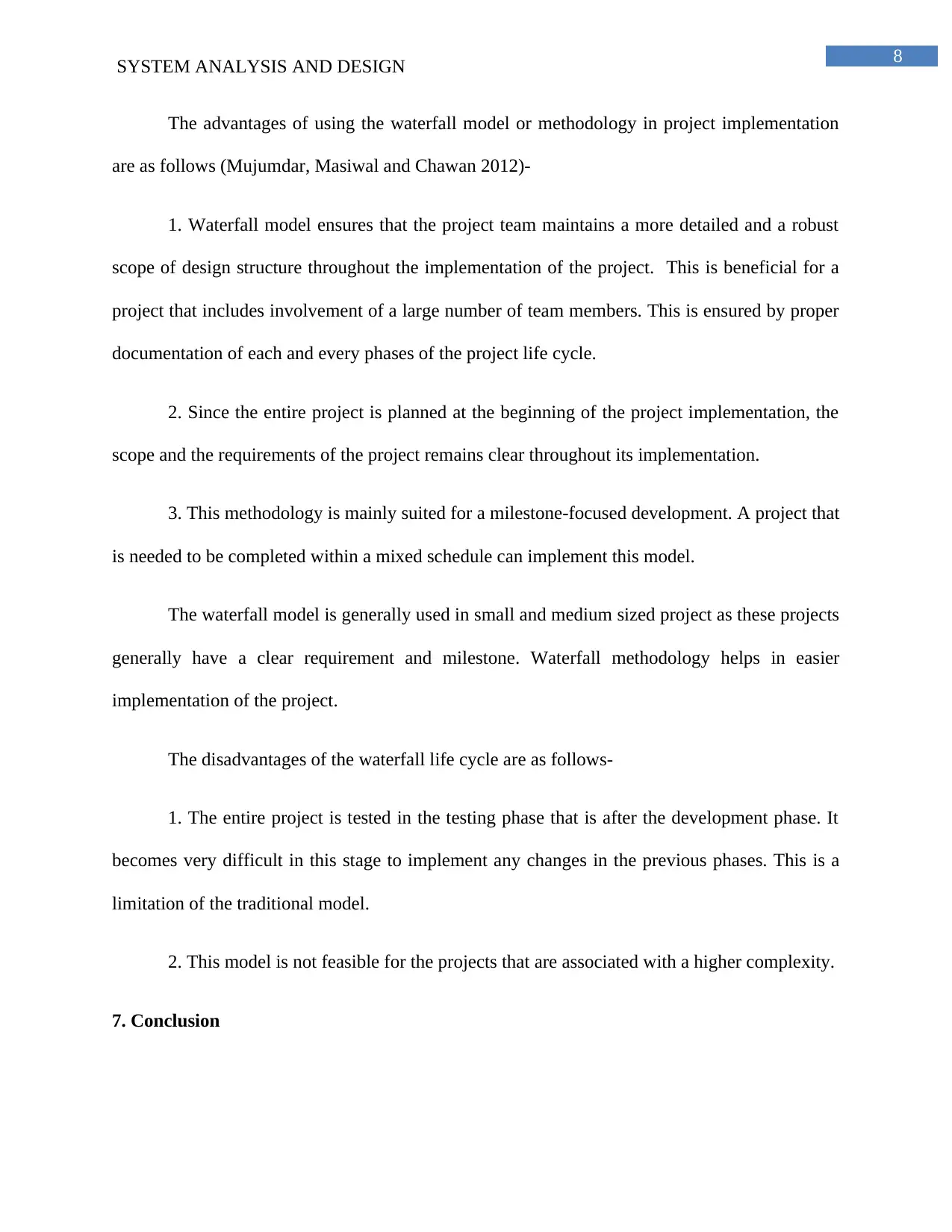
8
SYSTEM ANALYSIS AND DESIGN
The advantages of using the waterfall model or methodology in project implementation
are as follows (Mujumdar, Masiwal and Chawan 2012)-
1. Waterfall model ensures that the project team maintains a more detailed and a robust
scope of design structure throughout the implementation of the project. This is beneficial for a
project that includes involvement of a large number of team members. This is ensured by proper
documentation of each and every phases of the project life cycle.
2. Since the entire project is planned at the beginning of the project implementation, the
scope and the requirements of the project remains clear throughout its implementation.
3. This methodology is mainly suited for a milestone-focused development. A project that
is needed to be completed within a mixed schedule can implement this model.
The waterfall model is generally used in small and medium sized project as these projects
generally have a clear requirement and milestone. Waterfall methodology helps in easier
implementation of the project.
The disadvantages of the waterfall life cycle are as follows-
1. The entire project is tested in the testing phase that is after the development phase. It
becomes very difficult in this stage to implement any changes in the previous phases. This is a
limitation of the traditional model.
2. This model is not feasible for the projects that are associated with a higher complexity.
7. Conclusion
SYSTEM ANALYSIS AND DESIGN
The advantages of using the waterfall model or methodology in project implementation
are as follows (Mujumdar, Masiwal and Chawan 2012)-
1. Waterfall model ensures that the project team maintains a more detailed and a robust
scope of design structure throughout the implementation of the project. This is beneficial for a
project that includes involvement of a large number of team members. This is ensured by proper
documentation of each and every phases of the project life cycle.
2. Since the entire project is planned at the beginning of the project implementation, the
scope and the requirements of the project remains clear throughout its implementation.
3. This methodology is mainly suited for a milestone-focused development. A project that
is needed to be completed within a mixed schedule can implement this model.
The waterfall model is generally used in small and medium sized project as these projects
generally have a clear requirement and milestone. Waterfall methodology helps in easier
implementation of the project.
The disadvantages of the waterfall life cycle are as follows-
1. The entire project is tested in the testing phase that is after the development phase. It
becomes very difficult in this stage to implement any changes in the previous phases. This is a
limitation of the traditional model.
2. This model is not feasible for the projects that are associated with a higher complexity.
7. Conclusion
⊘ This is a preview!⊘
Do you want full access?
Subscribe today to unlock all pages.

Trusted by 1+ million students worldwide
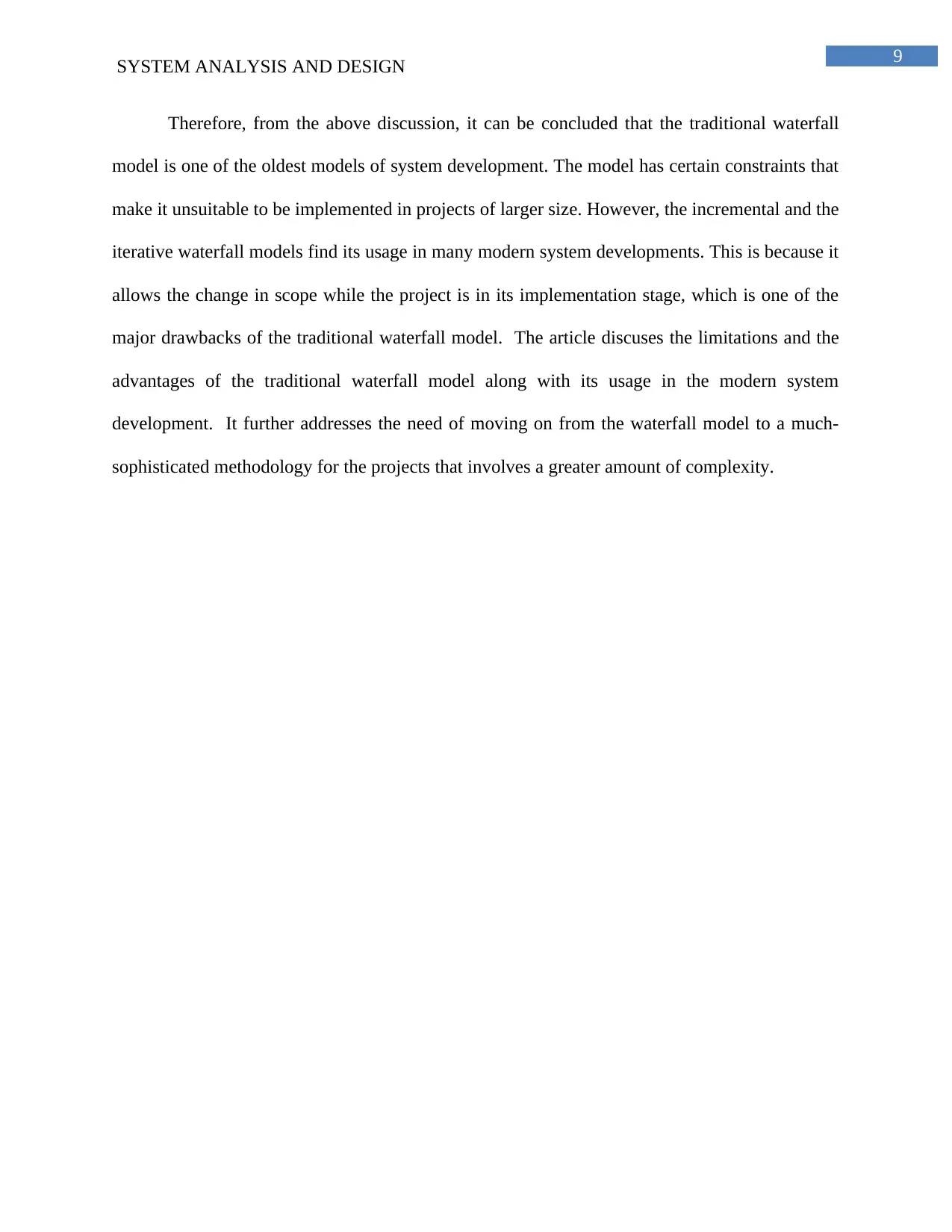
9
SYSTEM ANALYSIS AND DESIGN
Therefore, from the above discussion, it can be concluded that the traditional waterfall
model is one of the oldest models of system development. The model has certain constraints that
make it unsuitable to be implemented in projects of larger size. However, the incremental and the
iterative waterfall models find its usage in many modern system developments. This is because it
allows the change in scope while the project is in its implementation stage, which is one of the
major drawbacks of the traditional waterfall model. The article discuses the limitations and the
advantages of the traditional waterfall model along with its usage in the modern system
development. It further addresses the need of moving on from the waterfall model to a much-
sophisticated methodology for the projects that involves a greater amount of complexity.
SYSTEM ANALYSIS AND DESIGN
Therefore, from the above discussion, it can be concluded that the traditional waterfall
model is one of the oldest models of system development. The model has certain constraints that
make it unsuitable to be implemented in projects of larger size. However, the incremental and the
iterative waterfall models find its usage in many modern system developments. This is because it
allows the change in scope while the project is in its implementation stage, which is one of the
major drawbacks of the traditional waterfall model. The article discuses the limitations and the
advantages of the traditional waterfall model along with its usage in the modern system
development. It further addresses the need of moving on from the waterfall model to a much-
sophisticated methodology for the projects that involves a greater amount of complexity.
Paraphrase This Document
Need a fresh take? Get an instant paraphrase of this document with our AI Paraphraser
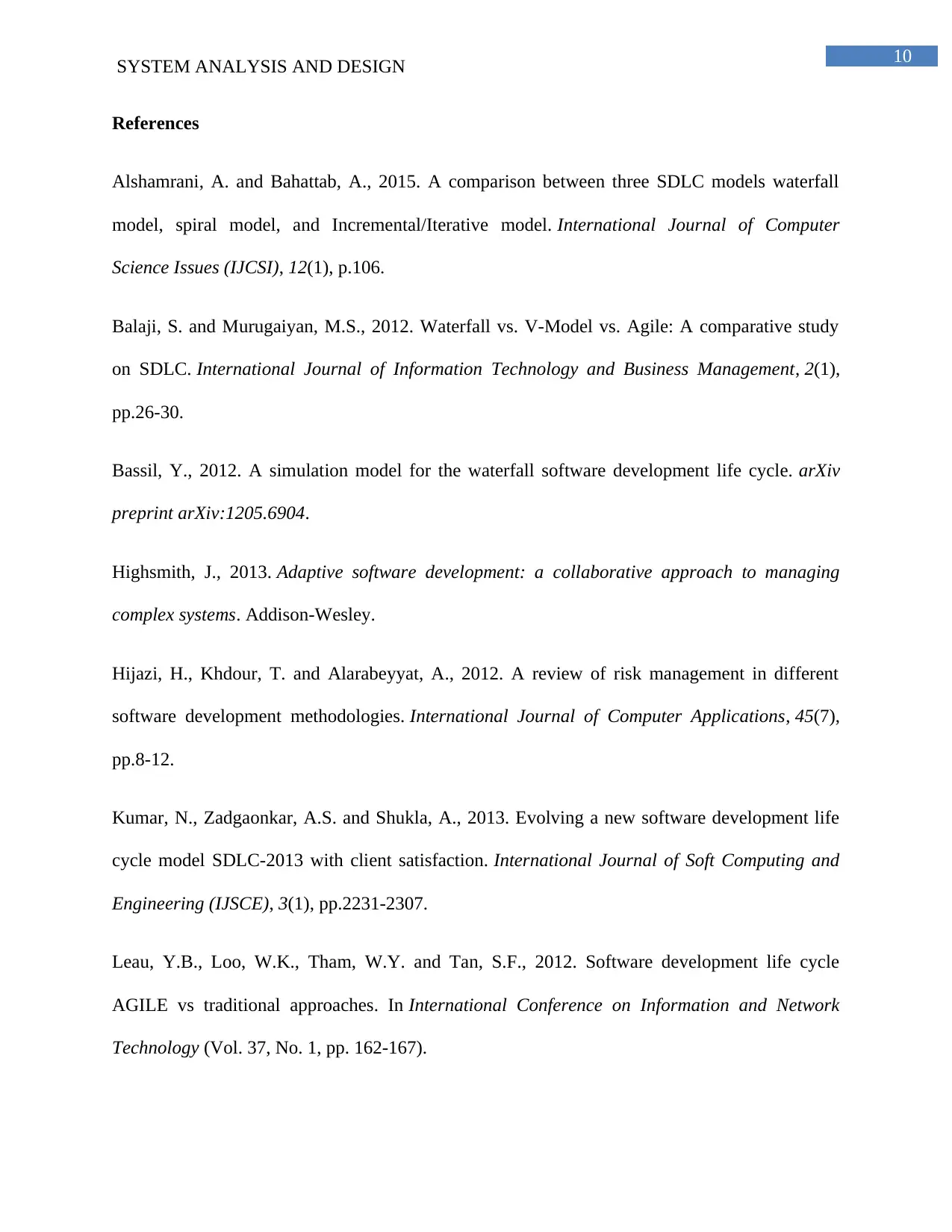
10
SYSTEM ANALYSIS AND DESIGN
References
Alshamrani, A. and Bahattab, A., 2015. A comparison between three SDLC models waterfall
model, spiral model, and Incremental/Iterative model. International Journal of Computer
Science Issues (IJCSI), 12(1), p.106.
Balaji, S. and Murugaiyan, M.S., 2012. Waterfall vs. V-Model vs. Agile: A comparative study
on SDLC. International Journal of Information Technology and Business Management, 2(1),
pp.26-30.
Bassil, Y., 2012. A simulation model for the waterfall software development life cycle. arXiv
preprint arXiv:1205.6904.
Highsmith, J., 2013. Adaptive software development: a collaborative approach to managing
complex systems. Addison-Wesley.
Hijazi, H., Khdour, T. and Alarabeyyat, A., 2012. A review of risk management in different
software development methodologies. International Journal of Computer Applications, 45(7),
pp.8-12.
Kumar, N., Zadgaonkar, A.S. and Shukla, A., 2013. Evolving a new software development life
cycle model SDLC-2013 with client satisfaction. International Journal of Soft Computing and
Engineering (IJSCE), 3(1), pp.2231-2307.
Leau, Y.B., Loo, W.K., Tham, W.Y. and Tan, S.F., 2012. Software development life cycle
AGILE vs traditional approaches. In International Conference on Information and Network
Technology (Vol. 37, No. 1, pp. 162-167).
SYSTEM ANALYSIS AND DESIGN
References
Alshamrani, A. and Bahattab, A., 2015. A comparison between three SDLC models waterfall
model, spiral model, and Incremental/Iterative model. International Journal of Computer
Science Issues (IJCSI), 12(1), p.106.
Balaji, S. and Murugaiyan, M.S., 2012. Waterfall vs. V-Model vs. Agile: A comparative study
on SDLC. International Journal of Information Technology and Business Management, 2(1),
pp.26-30.
Bassil, Y., 2012. A simulation model for the waterfall software development life cycle. arXiv
preprint arXiv:1205.6904.
Highsmith, J., 2013. Adaptive software development: a collaborative approach to managing
complex systems. Addison-Wesley.
Hijazi, H., Khdour, T. and Alarabeyyat, A., 2012. A review of risk management in different
software development methodologies. International Journal of Computer Applications, 45(7),
pp.8-12.
Kumar, N., Zadgaonkar, A.S. and Shukla, A., 2013. Evolving a new software development life
cycle model SDLC-2013 with client satisfaction. International Journal of Soft Computing and
Engineering (IJSCE), 3(1), pp.2231-2307.
Leau, Y.B., Loo, W.K., Tham, W.Y. and Tan, S.F., 2012. Software development life cycle
AGILE vs traditional approaches. In International Conference on Information and Network
Technology (Vol. 37, No. 1, pp. 162-167).
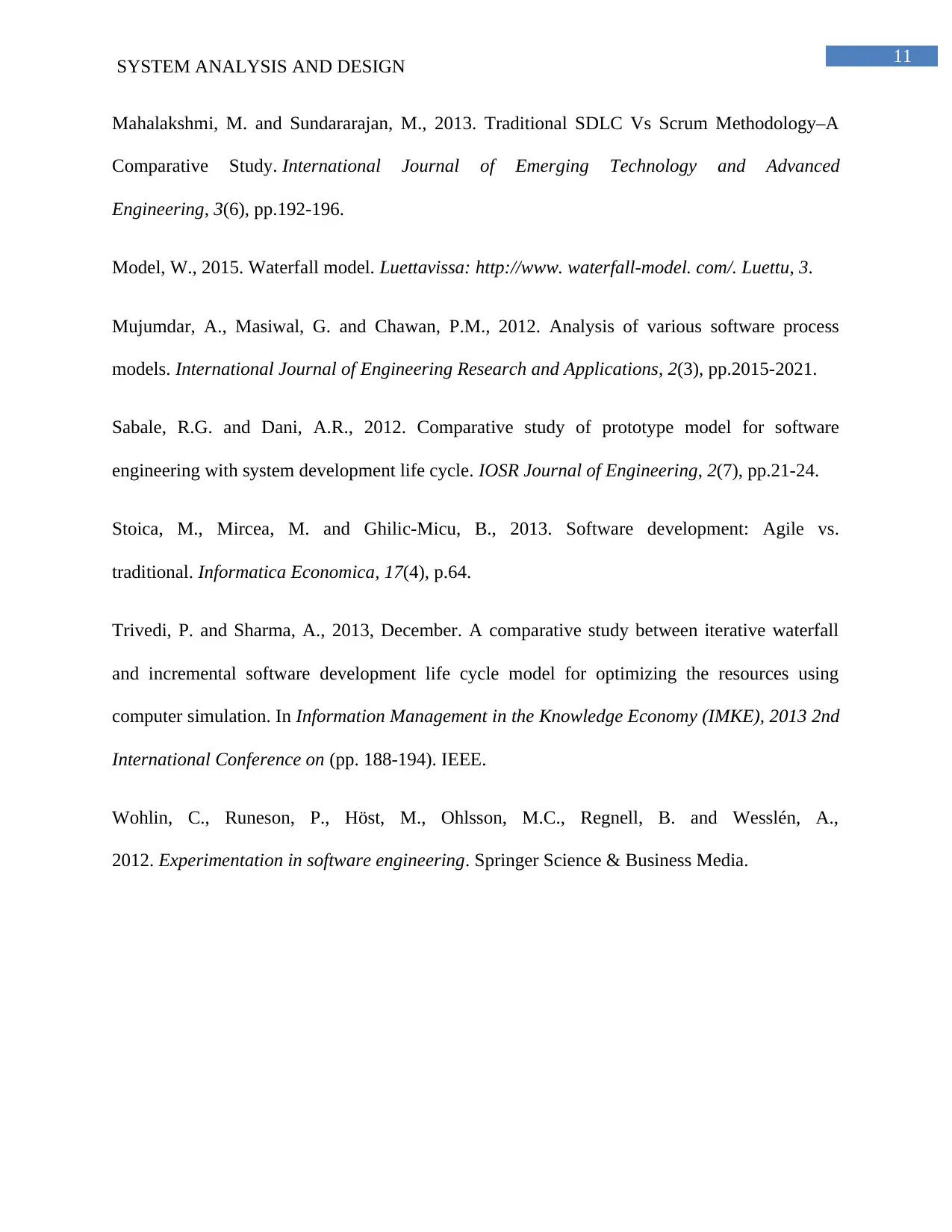
11
SYSTEM ANALYSIS AND DESIGN
Mahalakshmi, M. and Sundararajan, M., 2013. Traditional SDLC Vs Scrum Methodology–A
Comparative Study. International Journal of Emerging Technology and Advanced
Engineering, 3(6), pp.192-196.
Model, W., 2015. Waterfall model. Luettavissa: http://www. waterfall-model. com/. Luettu, 3.
Mujumdar, A., Masiwal, G. and Chawan, P.M., 2012. Analysis of various software process
models. International Journal of Engineering Research and Applications, 2(3), pp.2015-2021.
Sabale, R.G. and Dani, A.R., 2012. Comparative study of prototype model for software
engineering with system development life cycle. IOSR Journal of Engineering, 2(7), pp.21-24.
Stoica, M., Mircea, M. and Ghilic-Micu, B., 2013. Software development: Agile vs.
traditional. Informatica Economica, 17(4), p.64.
Trivedi, P. and Sharma, A., 2013, December. A comparative study between iterative waterfall
and incremental software development life cycle model for optimizing the resources using
computer simulation. In Information Management in the Knowledge Economy (IMKE), 2013 2nd
International Conference on (pp. 188-194). IEEE.
Wohlin, C., Runeson, P., Höst, M., Ohlsson, M.C., Regnell, B. and Wesslén, A.,
2012. Experimentation in software engineering. Springer Science & Business Media.
SYSTEM ANALYSIS AND DESIGN
Mahalakshmi, M. and Sundararajan, M., 2013. Traditional SDLC Vs Scrum Methodology–A
Comparative Study. International Journal of Emerging Technology and Advanced
Engineering, 3(6), pp.192-196.
Model, W., 2015. Waterfall model. Luettavissa: http://www. waterfall-model. com/. Luettu, 3.
Mujumdar, A., Masiwal, G. and Chawan, P.M., 2012. Analysis of various software process
models. International Journal of Engineering Research and Applications, 2(3), pp.2015-2021.
Sabale, R.G. and Dani, A.R., 2012. Comparative study of prototype model for software
engineering with system development life cycle. IOSR Journal of Engineering, 2(7), pp.21-24.
Stoica, M., Mircea, M. and Ghilic-Micu, B., 2013. Software development: Agile vs.
traditional. Informatica Economica, 17(4), p.64.
Trivedi, P. and Sharma, A., 2013, December. A comparative study between iterative waterfall
and incremental software development life cycle model for optimizing the resources using
computer simulation. In Information Management in the Knowledge Economy (IMKE), 2013 2nd
International Conference on (pp. 188-194). IEEE.
Wohlin, C., Runeson, P., Höst, M., Ohlsson, M.C., Regnell, B. and Wesslén, A.,
2012. Experimentation in software engineering. Springer Science & Business Media.
⊘ This is a preview!⊘
Do you want full access?
Subscribe today to unlock all pages.

Trusted by 1+ million students worldwide
1 out of 12
Related Documents
Your All-in-One AI-Powered Toolkit for Academic Success.
+13062052269
info@desklib.com
Available 24*7 on WhatsApp / Email
![[object Object]](/_next/static/media/star-bottom.7253800d.svg)
Unlock your academic potential
Copyright © 2020–2025 A2Z Services. All Rights Reserved. Developed and managed by ZUCOL.





